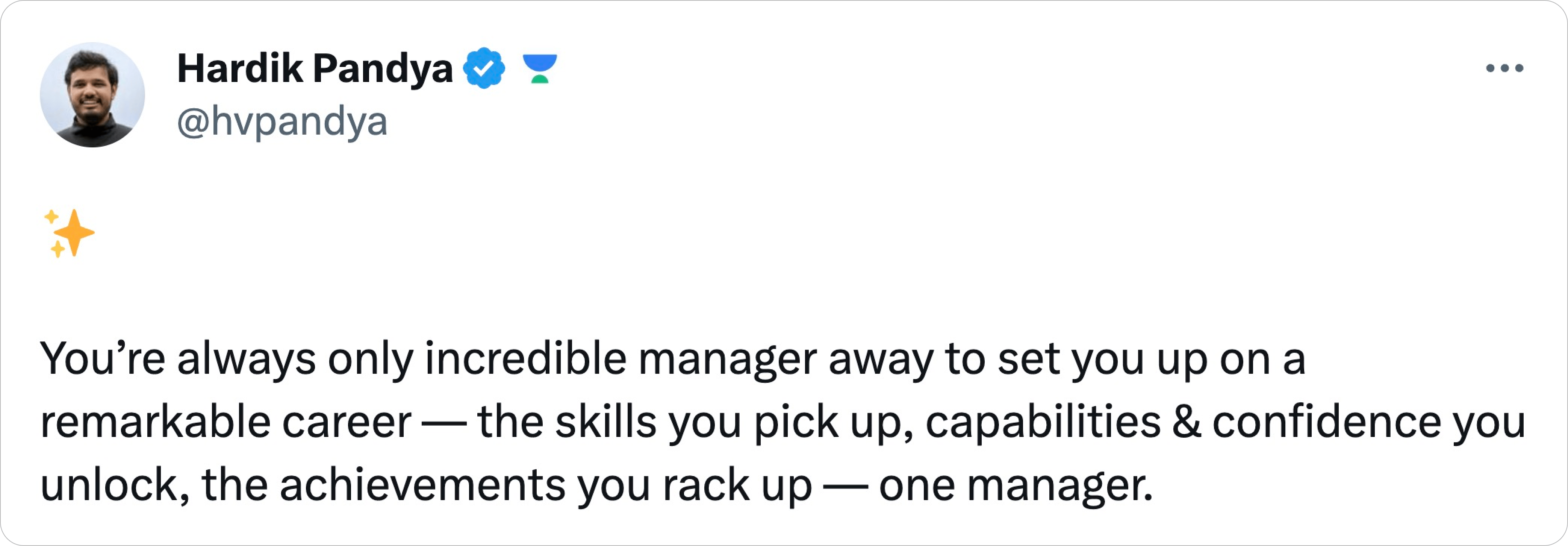Bad Design Managers
If you’ve been a designer for a few years, you’ve definitely heard of bad design managers. With any reasonable (bad) luck, you’d have had your own share of run-ins with such managers yourself.
The making of such managers
As designers gain experience in their careers, they tend to climb up the ranks on the career ladder. But at a certain point, the ladder runs out of levels for individual contributors. In order to continue their personal growth, IC designers have no choice but to become Design Managers. Becoming a manager is considered synonymous with seniority, personal growth and a sense of achievement compared to remaining an IC.
When they are awarded the role of a manager, these IC designers are seldom trained or primed for the additional responsibilities that come with becoming a manager. Most organizations do not even offer internal trainings or conduct formal communication to make the ICs aware of the additional accountability of the role.
The damage bad managers cause
Most new design managers end up on one of the two extremes:
- Keep operating like ICs, continue doing bulk of the work themselves
- Get into an extreme delegation mode, pushing all the work to their reports
Both of these are bad.
If they keep doing bulk of the work themselves, their reports feel isolated, underutilized and eventually end up not growing at all. This leads to frustration and stagnation for them. If they start delegating all the work to their reports, they can get overwhelmed, feel directionless and sometimes even start to get burned out under the unfiltered workload.
But the damage doesn’t stop there. Managers who are still stuck in their IC ways can often act in the interest of what I call ‘portfolio mode’. They get more interested in ensuring that their own individual portfolio strengthens at the expense of the team. There is a thorough lack of intent in investing any time or energy in the team’s growth.
Bad managers are often insecure without realizing it. Their need to move up the ladder faster than their reports can often cloud their judgment. While a good manager should actively focus on growing their team with them, the bad one can inadvertently end up ignoring the team’s growth entirely – in the end increasing the gap between them and the team. This can significantly slow down their team’s development and can often result in an extremely demotivated team.
Bad managers also tend to wave away people issues. As ICs, they didn’t really have the onus to address people issues earlier. Because of that, it becomes easier for them to disregard the people challenges their team may be facing. This leads to dissatisfied and disgruntled team members who often end up feeling underappreciated or even neglected.
Bad managers often exercise unjustified authority that they now seem to have gained, instead of serving the team that they’re now responsible for. The sense of power they now feel gets in the way of managing situations with tact, care and the due discernment. This leads to a team that is afraid of reporting problems, sharing ideas freely or disagreeing when they want to disagree.
What good design managers do
A good design manager focuses on 5 key responsibilities to build a healthy and happy team:
- Ensure a steady stream of challenging and meaningful work for you & your team
- Show where the quality bar is, by doing exemplary work yourself (per Steve Jobs, the best managers are stellar individual contributors who don’t want to be managers, but take the role on to maintain their quality standards)
- Protect time and focus of your reports so they can do their best work
- Communicate timely & clear feedback to every team member
- Create a personalized growth path for every member in the team
When you get better at these 5, you start observing how talented people in your team can start to grow. This growth is usually across a multitude of facets: their confidence, skills, communication, ownership and more.

Create great design managers
The best way to create great managers is to not force people into management because of poor career ladder design. Create an IC path that people can grow into, without having to reluctantly pick up management to grow on paper.
Assess their design abilities as an IC when you consider them for a design management role. Good design managers need to be able to keep the quality bar high, and give actionable feedback to every member of their team. For that to happen, they need to have walked the walk themselves. A lesser skilled IC will very likely make a bad design manager.
When an IC willingly wants to explore design management, the org should offer structured training to apprise them of the additional responsibilities that come with the role. Many orgs even have a way to do a practice run of management by making a design intern report to them for a while. This gives new managers an early taste of what the role is like.
Aspiring design managers should be continuously given feedback on their way of operating until they’re set on the path. A senior design leader can work with the new manager and share tactical tips to keep improving the way they manage their team. The leader can also help managers with the additional org context.
Design leadership should continually run surveys and pulse-check forums in order to gauge the happiness, satisfaction and motivation level of every manager’s reports. These surveys help measure how good of a job the managers are doing, and the areas of improvement their teams are calling out.
Design management is a tricky but important role. With an intentional setup, it’s a role that can make your Design org a very exciting place for the junior folks to join and grow in. The investment in nurturing this layer with intention is worth it.
Let me know your thoughts on design management.